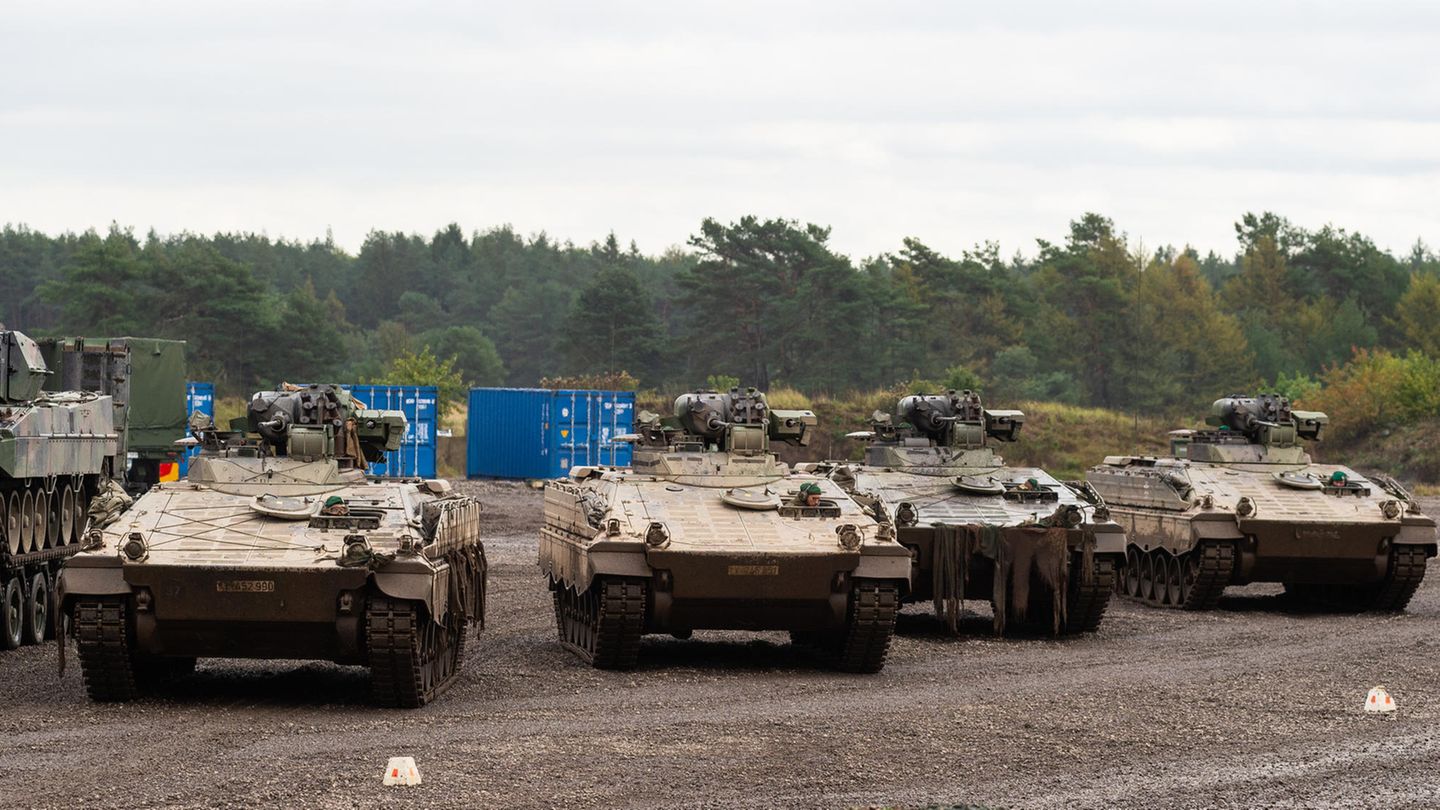Help Ukraine with everything you can. After Bucha and Kramatorsk, this position seems the only right one. Still, there are a few considerations that speak against the delivery of heavy weapons to Kyiv. Overview of a complicated debate.
The US is doing it, the Czechs have done it, and the Netherlands, Belgium and also Canada now want to do it: use heavy weapons to support Ukraine in its Putin-imposed war against Russia. With all the vociferous willingness, Germany’s hesitation is all the more striking. Chancellor Olaf Scholz has been under pressure for days to position himself on the issue of supplying heavy weapons to Kyiv. The pressure is also increasing from the factions of his traffic light partners.
On Tuesday, Scholz attempted a kind of liberation by announcing that he would set in motion a kind of detour financing: Ukraine will receive surplus, heavy equipment from NATO partner countries, and the Federal Republic will provide these countries with financial replacements. However, the weapons are still not supposed to come directly from Germany. Why not? An overview.
Heavy weapons – what does that actually mean?
There is no rigid boundary between light and heavy weapons. The 1990 CSCE Treaty, which established the number of conventional armed forces in Europe, identified five categories of heavy weapon systems: battle tanks, armored fighting vehicles, artillery, combat aircraft and combat helicopters. Warships are also likely to fall into the category.
What weapons does Ukraine want?
According to many observers, the war in Ukraine is now entering a new phase. After the setback near Kyiv, Putin reorganized his troops and declared the conquest of the entire Donbass as a priority war goal. But that means: “The character of the war will change completely. It is now highly likely that there will be a mechanized war, with major battles between mechanized units. It will become even bloodier, the fighting even more violent,” says Steffen Gady, an analyst at British Institute for International Strategic Studies, in an SZ interview.
And that requires weapon systems, such as those that Ukraine President Volodymyr Zelenskyj has been asking for like a prayer wheel for weeks: armored personnel carriers. main battle tank. Artillery. Selenskyj gave specific names and type designations: including multiple rocket launchers of the Smertsch or Grad type. Soviet T-72 tanks or similar American or German models. S-300 or BUK anti-aircraft systems and combat aircraft.
What has Germany delivered so far?
There is no official information on this. Even parliamentarians can only find out about it from the secret service of the Bundestag and are sworn to secrecy. At least we know from the early days of the war that Germany supplied Stinger and Strela anti-aircraft missiles. Also bazookas, machine guns, night vision goggles and armored vehicles. Not to forget the 5000 helmets that were so much ridiculed. A number is also circulating about the approximate volume. According to the Ministry of Economic Affairs, the federal government approved material worth 186 million euros for Ukraine by the end of March.
Since then, there have been hardly any reliable statements about the means by which Ukraine is currently being supported by Germany. Defense Minister Christine Lambrecht referred to the necessary secrecy “for security reasons”. At the end of March there were reports that the federal government had a list of armaments worth around 300 million euros that could be delivered to Ukraine at short notice. This was obviously not Bundeswehr material, but goods that the armaments industry could supply without much advance notice, including mortars, reconnaissance drones, ground surveillance radar devices and airspace surveillance systems, according to SZ information. There is no official information as to whether any of this has since been sent to Ukraine.
Are other NATO countries doing more?
Yes, definitely. Images circulated on Twitter of a train with several dozen Soviet-type T-72 tanks that is said to have left the Czech Republic for Ukraine. Before Easter, the United States had pledged to quickly deliver 11 Russian-design Mi-17 helicopters, 200 M113 armored personnel carriers and 18 155-millimeter field howitzers with 40,000 artillery shells to Ukraine to deliver. Yesterday Belgium and the Netherlands had already made it clear that they were willing to supply heavy weapons.
What could Germany do?
Opinions differ greatly on this. In his press conference yesterday, Chancellor Olaf Scholz made it clear that a delivery from Bundeswehr stocks is hardly possible. “Here we have to recognize that the possibilities we have are reaching their limits,” said Scholz. The background is that the Bundeswehr claims its heavy weapons for itself in order to be able to guarantee the defense of the country and the alliance. This applies, for example, to the Marder infantry fighting vehicle or the Panzerhaubitze 2000, a heavy artillery piece.
However, the German armaments industry has a number of used weapon systems in storage that it would like to sell but has not yet reworked to be ready for use. These include Marder armored personnel carriers from the Rheinmetall armory. There was also talk of decommissioned Leopard 1 main battle tanks. An idea that is in the air: The Bundeswehr could submit, provide Ukraine with heavy weapons and, after a waiting period, receive outdated equipment. However, this in turn is viewed critically by the military leadership. “In order to operate the armed forces and also to train follow-up forces, we need the weapon systems,” said the Deputy Inspector General of the Bundeswehr, Markus Laubenthal, in the ZDF “Morgenmagazin”.
Could the Ukrainians handle German Leopard and Marder tanks at all?
There are different statements about this. The German side refers to extensive training for such “posts”. Ukraine does not accept this and wants training and commitments now if possible, in order to have firepower and protected movement on the battlefield in a few months. It is about soldiers of the Panzertruppe who could transfer their knowledge to the new device.
However, the delivery alone is not enough. Spare parts and maintenance work are required for the operation of the heavy equipment. A task that requires trained personnel.
What speaks for the delivery of heavy weapons?
Putin will not stop! This is the compelling-sounding argument of the advocates of arms deliveries. There are also fears circulating in NATO that Putin will turn his attention to countries such as Moldova or the Baltic states if arms are successful in Ukraine. From this follows the logic that Ukraine is fighting with the resistance against the Russian attack “also for us” and in this respect deserves every support.
What speaks against it?
Certainly, from a moral point of view, supporting Ukraine with everything possible seems imperative. However, there was and still is a red line in all NATO considerations: Don’t give Vladimir Putin an excuse for being perceived as a war party. Because that could, it is feared, possibly set an escalation spiral in Ganz and ultimately lead to a nuclear war.
The support of warring parties with arms deliveries is covered by international law, as Justice Minister Marco Buschmann recently pointed out. On the other hand, at the beginning of the war, Putin had already warned the NATO states against interfering, citing the unprecedented consequences. What was definitely perceived in NATO as a threat of nuclear weapons. Concerns that the Kremlin chief might react aggressively to the delivery of heavy NATO equipment are therefore not entirely unfounded.
Source: Stern
David William is a talented author who has made a name for himself in the world of writing. He is a professional author who writes on a wide range of topics, from general interest to opinion news. David is currently working as a writer at 24 hours worlds where he brings his unique perspective and in-depth research to his articles, making them both informative and engaging.




